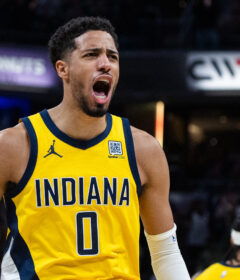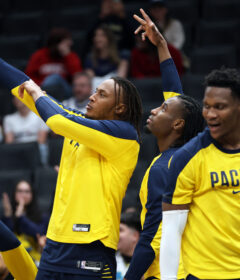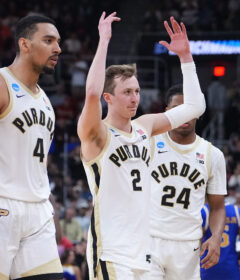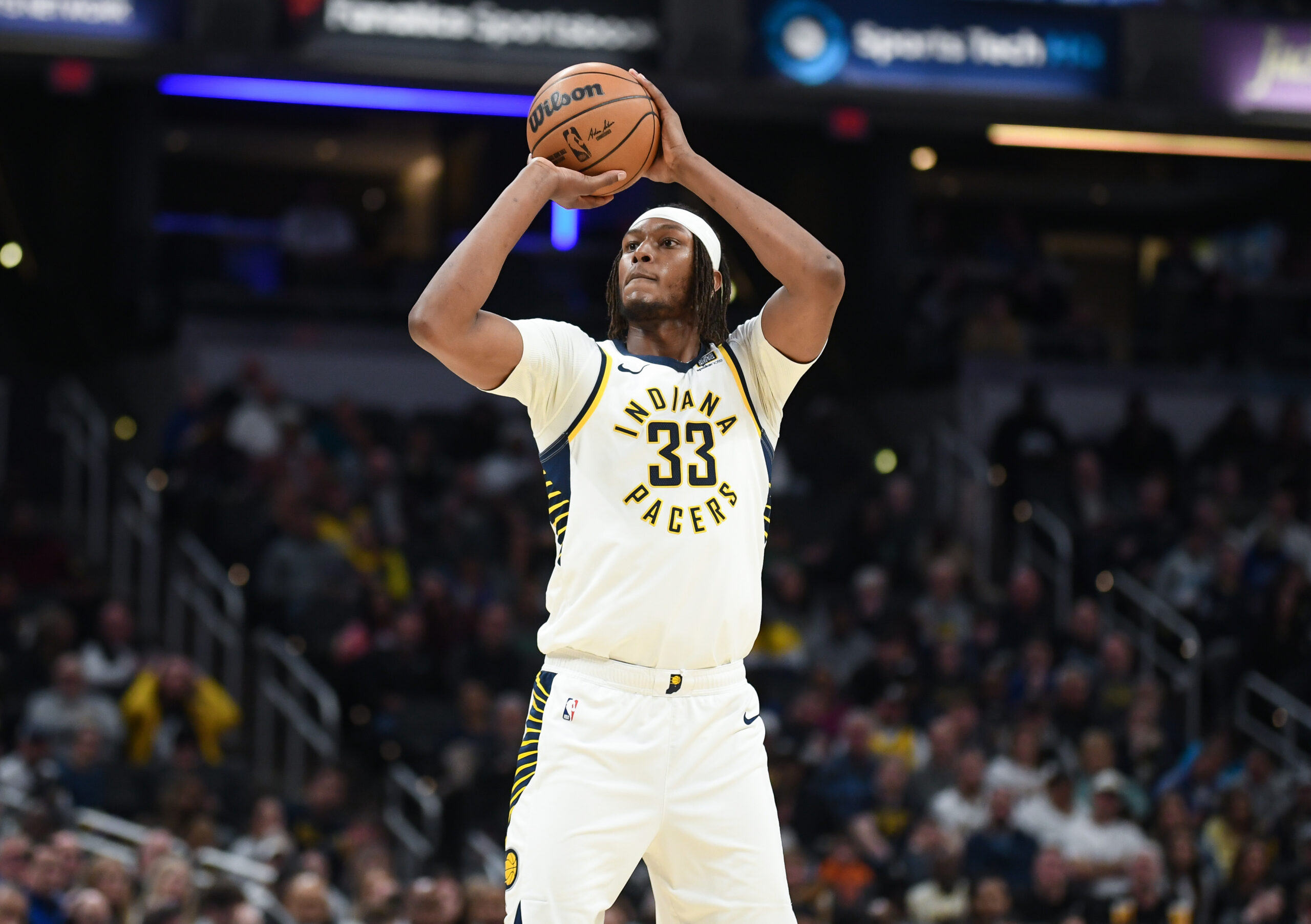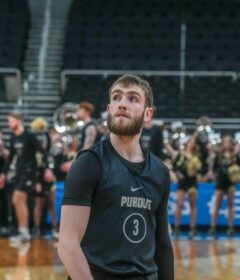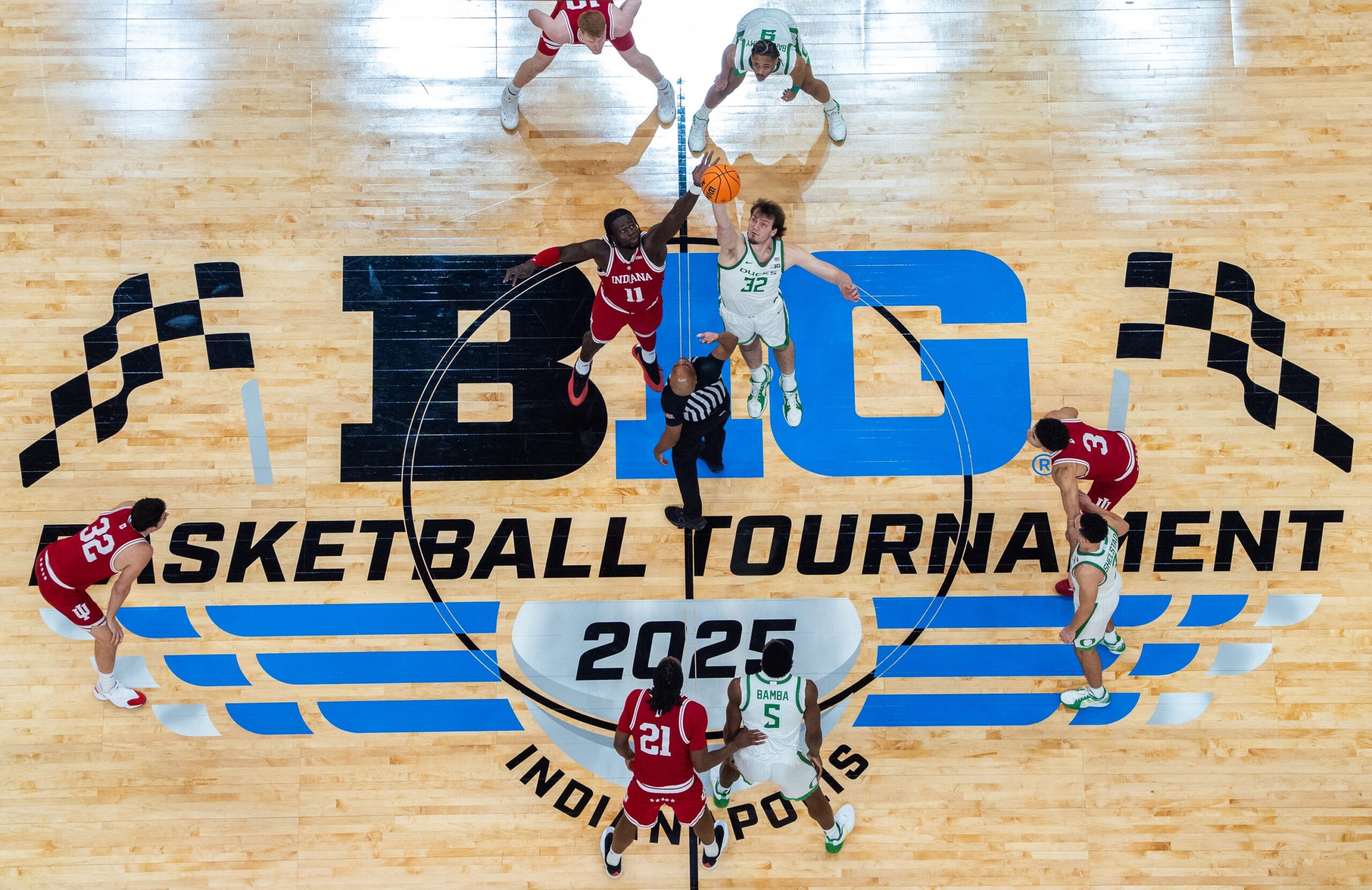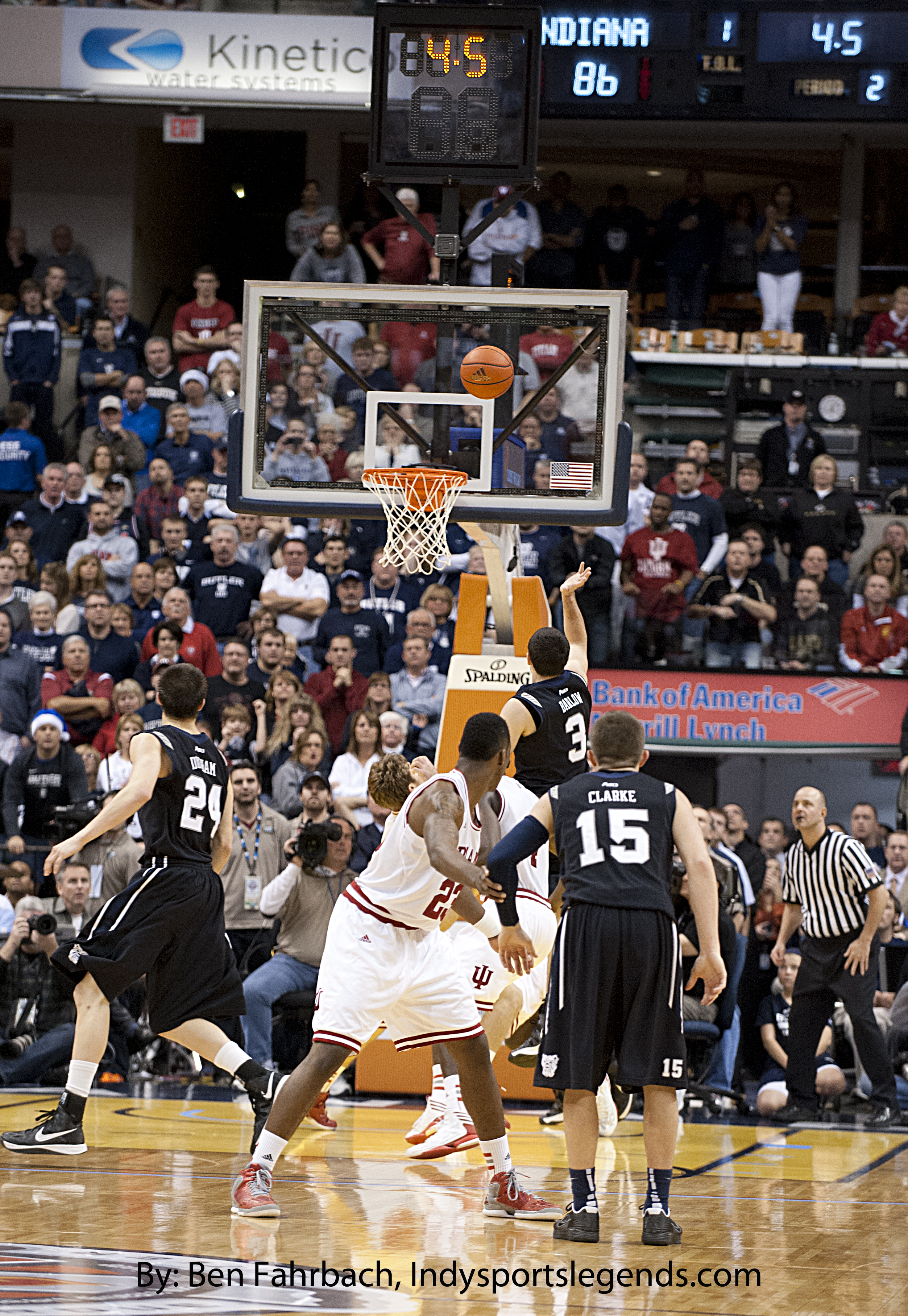
By CHRIS GOFF
ISL Correspondent
Three days later, and the state is still buzzing. Alex Barlow’s name and story still resonate. As to how Butler actually beat No. 1 Indiana, there still is some consternation, but the Bulldogs are now ranked for the first time in two years.
Rather than rehashing an admittedly thrilling game, let’s use Butler’s 88-86 win as a window into the future. Here are six things we learned about Butler Saturday, with a bonus of four quick-hitters on the one-loss Hoosiers.
Butler can win a high-scoring game.
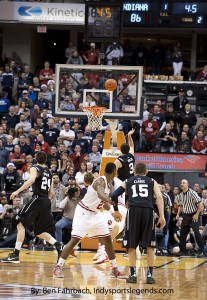
The Bulldogs were skilled enough to pull out a victory after allowing their opponent to approach 90 on the scoreboard. Symbolic of good teams is the versatility to win games of all stripes – high-scoring, low-scoring, fast, slow, ugly, pretty, close, blowouts and comebacks. Butler’s latest upset was anything but classic Butler. Last year’s team couldn’t have done it. Yet Brad Stevens can check another box and know his new-look roster can get by in an NCAA tournament game played in the high 70s.
Rotnei Clarke is a bonafide No. 1 option.
Clarke is front and center on Butler’s offense partly out of necessity, yes, but his place holds in theory, too. He played all 45 minutes Saturday and had such a spring in his step at the end that he might have been fine going another overtime. Stevens has dialed back Clarke’s role in running the offense because of what a brilliant scorer he is. While Barlow and Roosevelt Jones handle the rock, Clarke can run his man ragged off screens. He has ridiculous range on his shot. How he aims it so well while stationed so far from the basket is a point of amazement. But what stood out Saturday was how he managed to score 19 points. When Victor Oladipo guarded Clarke in halfcourt sets, Clarke could scarcely find daylight, let alone points. Yet Butler couldn’t win without him, and Clarke still found a way to produce. Like Shelvin Mack, Clarke is a reliable lead scorer who’ll be there night in and night out and wouldn’t allow himself to be kept quiet in Saturday’s proceedings. He’s the real deal.
Roosevelt Jones is more important to Butler’s fate than Kellen Dunham.
This development is at odds with my expectations entering the season. Jones’ early play is quite a welcome surprise for the Bulldogs. While Dunham isn’t a 13- or 14-point scorer right off the bat, Jones is Butler’s best interior passer, rebounds well for his size and creates offense for teammates. He doesn’t shoot like Dunham, but that’s a good thing. Jones gets points by taking larger guys off the dribble and bullying smaller defenders in the post. Dunham suffers a bit because so many of his skills duplicate what Clarke already provides. Jones shot 45.5 percent from the field as a freshman and is up to 52.2 percent. Moreover, his assists have risen from 1.6 per game to 3.6. On a team lacking a true point guard, that distribution is why Jones is on the same tier as Clarke, Khyle Marshall and Andrew Smith in terms of affecting Butler’s outlook – to say nothing of Jones’ ability to defend four positions.
Erik Fromm is no longer the designated thrower of long inbounds passes. He’s the third big man.
Kameron Woods earned 634 minutes to Erik Fromm’s 397 last season. Each played 36 games, so the only logical conclusion is that Stevens rated Woods more highly on the depth chart. This year we’ve seen Fromm establish himself as the backup center. Fromm won’t score in the post, but he’s come a long way since his menial freshman year role of entering for one-arm heaves when Butler needed long passes at the end of halves. Fromm’s 10 points were instrumental in defeating the Hoosiers, who had four double-digit scorers to Butler’s five. Fromm is playing only about two minutes more per game than Woods, but Stevens reveals who he’s most comfortable with in big games. Against Marquette, Northwestern and Indiana, Woods played just 19 minutes to Fromm’s 46. Fromm has performed really well three games in a row, so his arrow is only trending upward.
Alex Barlow deserves to start.
Entering Saturday, Barlow had 18 points total in college. He finished with a career-high six. He has been starting while Dunham adjusts to the college game. He’s quite a find for Butler. Barlow’s pure point rating of 2.03 is best on the team and — to add perspective — would rate in the top 140 nationally among players averaging at least 20 minutes (Barlow averages 13). Whenever Barlow’s out there, he’s picking up rebounds, assists or steals, or some of all three. On top of that, he can be a very effective defender. Chase Stigall, another option, is perceived as a useful, Zach Hahn type shooter. The truth is Stigall simply isn’t very good. Barlow has played well enough that he ought to remain right where he is.
Butler’s likely headed to the NCAA tournament.
Indiana coach Tom Crean said the Bulldogs are really good. He would say that after a loss, of course. But much evidence points in Butler’s favor. Stevens is gangbusters as a game coach. You have your recruiting warriors, but it only takes one hand to add up the number of coaches who can prepare and manage a team for a single, 40-minute contest as well as Stevens can. Consider: Butler endured a complete meltdown at the end of regulation, and in a contest that had no business being in overtime, the Bulldogs were barely fazed. Butler has had its share of problems closing victories. Stevens will correct those issues. Andrew Smith played with more toughness and confidence than he did against Cody Zeller last season. That bodes well going forward. The bottom line is it’s going to be very tough to knock off North Carolina, Marquette, Northwestern and Indiana and not make a field of 68 out of a strong, multi-bid conference like the Atlantic 10.
Jordan Hulls is a weak link defensively.
On the game-deciding play, Barlow got a very good look at the basket. Hulls was neither in front of Barlow nor had a hand in Barlow’s face. The other four Hoosiers were like cornerbacks who had all the receivers covered, while Hulls was the pass rusher who, instead of getting the “coverage” sack, let the quarterback escape and scramble for a first down. Hulls also bit fiercely on a ball fake by Stigall in overtime, ending up in no man’s land for no real reason as Stigall was left all alone for a go-ahead 3 in the final minute. Hulls is undersized and can be beaten off the dribble.
Indiana didn’t go for the kill.
Even though Butler blew a seven-point lead with 2 minutes left, Indiana has the pain of knowing it led most of the way. Theoretically the Hoosiers scored enough to win, despite just-OK shooting. But the defense wasn’t tight enough, despite the fact Butler scored on a lot of broken plays. Indiana never guarded with a sense of urgency to put the game away. The Hoosiers need to hone their killer instinct on that end. After all, getting stops is another method of stretching leads.
Yogi Ferrell isn’t afraid of anything.
For a freshman who usually is the fifth scoring option on the floor to nail a game-saving 3 is impressive. It indicates Ferrell is far from soft. He’s mentally tough and more than ready to play big-time college basketball and contribute to a Final Four run.
Cody Zeller looks like the same player he was last season.
I didn’t think Zeller fared as poorly as some have said – 18 points is still 18 points – but by his lofty standards, Zeller left not much of an imprint on Saturday’s showdown. He was beaten several times defensively after Smith drug him out of the paint. In the aggregate, Zeller is not breaking out in his sophomore season. By most measurements he has picked up where he left off as a freshman. He was a great freshman, mind you, so Indiana’s fine, but the Hoosiers are still waiting on tangible improvement.
Follow Chris Goff on Twitter: www.twitter.com/chrisgoff_ISL.
Related Posts
- Hoosiers year in review: Brilliant season fell short of goal
- Indiana’s season ends abruptly with loss to Syracuse in Sweet 16
- Michigan-Indiana game should be real treat for fans
- What’s wrong with the Hoosiers? 5 things IU needs to address
- Badgers snap Indiana’s 18-game home win streak
- Fahrbach’s slideshow: Indiana vs. Butler
- No. 22 Notre Dame improves to 9-1 with 81-68 win over slumping Purdue
- Crossroads Classic Game 1 preview: Butler vs. Indiana
- Hoosiers move to 6-0 as Ferrell sets assist record
- Cody Zeller shows growing comfort in return to Indiana

